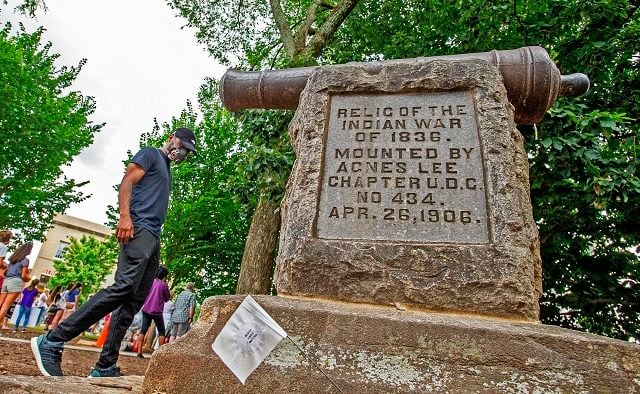Beacon Hill Alliance seeks removal of ‘Indian War’ monument
[adsanity align=’alignnone’ id=63841]
 The cannon from the Indian War of 1836 that Andre Williams is walking past is one of the monuments to hate and white supremacy currently located around the historic DeKalb County courthouse that were demanded to be removed during the Beacon Hill Black Alliance for Human Rights “Take It Down-No More Monuments to White Supremacy” rally on the Decatur Square June 17, 2020. Photo by Dean Hesse.
The cannon from the Indian War of 1836 that Andre Williams is walking past is one of the monuments to hate and white supremacy currently located around the historic DeKalb County courthouse that were demanded to be removed during the Beacon Hill Black Alliance for Human Rights “Take It Down-No More Monuments to White Supremacy” rally on the Decatur Square June 17, 2020. Photo by Dean Hesse.
By Sara Amis, contributor
Decatur, GA — The Beacon Hill Black Alliance for Human Rights, following the removal of the Confederate memorial statue in the square near the old Decatur Court House, is now circulating a petition seeking the removal of another monument, placed by the United Daughters of the Confederacy in 1906.
The monument incorporates a cannon used in the “Indian War” of 1836, one phase of the forced removal of entire Choctaw, Seminole, Muskogee, Chickasaw, and Cherokee communities from their ancestral lands, an event widely known as the “Trail of Tears.”
The Beacon Hill Alliance this past weekend held a conference, hosted in partnership with Agnes Scott College’s MacDougall Center for Global Diversity and Inclusion, partially to support the removal of the monument but also to discuss the history and current status of indigenous people in the Southeast and beyond.
“This Land Tells A Story: Decatur’s Indigenous-African Connections,” was held via Zoom on November 14.
[adsanity id=”59104″ align=”alignleft” /] [adsanity id=”56211″ align=”alignright” /]
Natsu Taylor Saito, a Distinguished Professor at Georgia State University’s College of Law, said that the petition to remove the 1906 monument had garnered less attention than the Confederate monument partially because people were less familiar with the history. Saito stated that the absence of indigenous people’s history, as well as their violent removal, served the purpose of asserting the legitimacy of colonization.
“In order to claim sovereignty over the land, settlers had to make indigenous people disappear, literally or conceptually,” said Saito. Saito pointed out that the next step in the process was to make the land profitable via chattel slavery.
Dr. Akinyele Umoja, Professor of Africana Studies at Georgia State University said, “The Trail of Tears was based on driving indigenous people off the land so that African people could be brought here and enslaved. Our destinies are linked.”
Beth Michel, who is Associate Dean of Admission and Lead for Native American Outreach at Emory University and a Tohono O’odham citizen, said that the erasure of indigenous people and their impact is ongoing. CNN recently presented data on voting percentages for white, Black, Asian, and Latinx voters, but labeled indigenous voters as “something else.”
Michel pointed out that this happened during an election in which a map of Arizona shows that indigenous voters overwhelmingly supported Biden and contributed to his victory in that state.
“You can clearly see that the Native vote was strong,” said Michel.
Michel stated that the election of indigenous members of Congress such as Sharice Davids and Deb Haaland shows the results of growing indigenous political power. Haaland is being suggested as a possible Secretary of the Interior, which would make her the first indigenous person to hold a Cabinet-level post. The Bureau of Indian Affairs is part of the Interior and so are public lands held by the United States government.
“An indigenous woman to oversee public lands, our traditional homelands, is also an important move and I hope that comes to fruition,” said Michel.
[adsanity id=”61010″ align=”alignleft” /] [adsanity id=”59208″ align=”alignright” /]
Saito pointed out that exercising the vote helps but elections don’t automatically solve the problems of disproportionate poverty, violence, and disempowerment that affect indigenous and Black people.
“Historically they’ve always gotten a little better and a little worse, and we’re all grateful that it looks like they’ll get a little better now,” said Saito, adding that she believed a fundamental change would only come after confronting what it means to have a society built on stolen land.
The event was interrupted by a Zoom bombing that included pornographic images, epithets, and threats.
After the meeting was reconvened, Umoja said, “We’re under attack. Indigenous people, African people, and anyone who wants liberation. I applaud the Beacon Hill Black Alliance and Agnes Scott College for even having this conversation.”
Jon Winterhawk Johnson, a member of the Southeastern Mvskoke-Creek Nation, said that reconciliation and solving deeper problems would be difficult while still surrounded by statues and weapons and symbols of war that glorify the violence of the past and reinforce the status quo.
Johnson said, “That’s a mindset that we need to get away from in order to go into the future and a way of peace. If we don’t have peace, we don’t have freedom. That’s what it boils down to.”
If you appreciate our work on this story, please become a paying supporter. For as little as $3 a month, you can help us keep you in the loop about your community. To become a supporter, click here.
Want Decaturish delivered to your inbox every day? Sign up for our free newsletter by clicking here.
[adsanity id=”56022″ align=”aligncenter” /]
[adsanity id=”59106″ align=”alignleft” /] [adsanity id=”52166″ align=”alignright” /]
